[English] 日本語
 Yorodumi
Yorodumi- PDB-6ukj: Single-Particle Cryo-EM Structure of Plasmodium falciparum Chloro... -
+ Open data
Open data
- Basic information
Basic information
| Entry | Database: PDB / ID: 6ukj | ||||||||||||||||||||||||||||||
|---|---|---|---|---|---|---|---|---|---|---|---|---|---|---|---|---|---|---|---|---|---|---|---|---|---|---|---|---|---|---|---|
| Title | Single-Particle Cryo-EM Structure of Plasmodium falciparum Chloroquine Resistance Transporter (PfCRT) 7G8 Isoform | ||||||||||||||||||||||||||||||
 Components Components |
| ||||||||||||||||||||||||||||||
 Keywords Keywords | MEMBRANE PROTEIN / Transporter / drug resistance / digestive vacuole of malaria parasite / nanodisc | ||||||||||||||||||||||||||||||
| Function / homology | Chloroquine-resistance transporter-like / Chloroquine resistance transporter / CRT-like, chloroquine-resistance transporter-like / vacuolar membrane / xenobiotic transmembrane transporter activity / membrane => GO:0016020 / CHOLESTEROL HEMISUCCINATE / Chloroquine resistance transporter Function and homology information Function and homology information | ||||||||||||||||||||||||||||||
| Biological species |   Homo sapiens (human) Homo sapiens (human) | ||||||||||||||||||||||||||||||
| Method | ELECTRON MICROSCOPY / single particle reconstruction / cryo EM / Resolution: 3.3 Å | ||||||||||||||||||||||||||||||
 Authors Authors | Kim, J. / Tan, Y.Z. / Wicht, K.J. / Erramilli, S.K. / Dhingra, S.K. / Okombo, J. / Vendome, J. / Hagenah, L.M. / Giacometti, S.I. / Warren, A.L. ...Kim, J. / Tan, Y.Z. / Wicht, K.J. / Erramilli, S.K. / Dhingra, S.K. / Okombo, J. / Vendome, J. / Hagenah, L.M. / Giacometti, S.I. / Warren, A.L. / Nosol, K. / Roepe, P.D. / Potter, C.S. / Carragher, B. / Kossiakoff, A.A. / Quick, M. / Fidock, D.A. / Mancia, F. | ||||||||||||||||||||||||||||||
| Funding support |  United States, 9items United States, 9items
| ||||||||||||||||||||||||||||||
 Citation Citation |  Journal: Nature / Year: 2019 Journal: Nature / Year: 2019Title: Structure and drug resistance of the Plasmodium falciparum transporter PfCRT. Authors: Jonathan Kim / Yong Zi Tan / Kathryn J Wicht / Satchal K Erramilli / Satish K Dhingra / John Okombo / Jeremie Vendome / Laura M Hagenah / Sabrina I Giacometti / Audrey L Warren / Kamil Nosol ...Authors: Jonathan Kim / Yong Zi Tan / Kathryn J Wicht / Satchal K Erramilli / Satish K Dhingra / John Okombo / Jeremie Vendome / Laura M Hagenah / Sabrina I Giacometti / Audrey L Warren / Kamil Nosol / Paul D Roepe / Clinton S Potter / Bridget Carragher / Anthony A Kossiakoff / Matthias Quick / David A Fidock / Filippo Mancia /  Abstract: The emergence and spread of drug-resistant Plasmodium falciparum impedes global efforts to control and eliminate malaria. For decades, treatment of malaria has relied on chloroquine (CQ), a safe and ...The emergence and spread of drug-resistant Plasmodium falciparum impedes global efforts to control and eliminate malaria. For decades, treatment of malaria has relied on chloroquine (CQ), a safe and affordable 4-aminoquinoline that was highly effective against intra-erythrocytic asexual blood-stage parasites, until resistance arose in Southeast Asia and South America and spread worldwide. Clinical resistance to the chemically related current first-line combination drug piperaquine (PPQ) has now emerged regionally, reducing its efficacy. Resistance to CQ and PPQ has been associated with distinct sets of point mutations in the P. falciparum CQ-resistance transporter PfCRT, a 49-kDa member of the drug/metabolite transporter superfamily that traverses the membrane of the acidic digestive vacuole of the parasite. Here we present the structure, at 3.2 Å resolution, of the PfCRT isoform of CQ-resistant, PPQ-sensitive South American 7G8 parasites, using single-particle cryo-electron microscopy and antigen-binding fragment technology. Mutations that contribute to CQ and PPQ resistance localize primarily to moderately conserved sites on distinct helices that line a central negatively charged cavity, indicating that this cavity is the principal site of interaction with the positively charged CQ and PPQ. Binding and transport studies reveal that the 7G8 isoform binds both drugs with comparable affinities, and that these drugs are mutually competitive. The 7G8 isoform transports CQ in a membrane potential- and pH-dependent manner, consistent with an active efflux mechanism that drives CQ resistance, but does not transport PPQ. Functional studies on the newly emerging PfCRT F145I and C350R mutations, associated with decreased PPQ susceptibility in Asia and South America, respectively, reveal their ability to mediate PPQ transport in 7G8 variant proteins and to confer resistance in gene-edited parasites. Structural, functional and in silico analyses suggest that distinct mechanistic features mediate the resistance to CQ and PPQ in PfCRT variants. These data provide atomic-level insights into the molecular mechanism of this key mediator of antimalarial treatment failures. | ||||||||||||||||||||||||||||||
| History |
|
- Structure visualization
Structure visualization
| Movie |
 Movie viewer Movie viewer |
|---|---|
| Structure viewer | Molecule:  Molmil Molmil Jmol/JSmol Jmol/JSmol |
- Downloads & links
Downloads & links
- Download
Download
| PDBx/mmCIF format |  6ukj.cif.gz 6ukj.cif.gz | 118.5 KB | Display |  PDBx/mmCIF format PDBx/mmCIF format |
|---|---|---|---|---|
| PDB format |  pdb6ukj.ent.gz pdb6ukj.ent.gz | 91 KB | Display |  PDB format PDB format |
| PDBx/mmJSON format |  6ukj.json.gz 6ukj.json.gz | Tree view |  PDBx/mmJSON format PDBx/mmJSON format | |
| Others |  Other downloads Other downloads |
-Validation report
| Arichive directory |  https://data.pdbj.org/pub/pdb/validation_reports/uk/6ukj https://data.pdbj.org/pub/pdb/validation_reports/uk/6ukj ftp://data.pdbj.org/pub/pdb/validation_reports/uk/6ukj ftp://data.pdbj.org/pub/pdb/validation_reports/uk/6ukj | HTTPS FTP |
|---|
-Related structure data
| Related structure data |  20806MC M: map data used to model this data C: citing same article ( |
|---|---|
| Similar structure data | |
| EM raw data |  EMPIAR-10330 (Title: 3.2 Å Single-Particle Cryo-EM Reconstruction of 49 kDa Membrane-Bound PfCRT Complexed with Fab EMPIAR-10330 (Title: 3.2 Å Single-Particle Cryo-EM Reconstruction of 49 kDa Membrane-Bound PfCRT Complexed with FabData size: 830.4 Data #1: Unaligned and compressed multi-frame micrographs [micrographs - multiframe] Data #2: Aligned and magnification anisotropy corrected micrographs [micrographs - single frame] Data #3: Final Particle Stack with Refined Euler Angles and Shifts [picked particles - single frame - processed]) |
- Links
Links
- Assembly
Assembly
| Deposited unit | 
|
|---|---|
| 1 |
|
- Components
Components
| #1: Protein | Mass: 53074.461 Da / Num. of mol.: 1 Source method: isolated from a genetically manipulated source Source: (gene. exp.)  Strain: isolate 7G8 / Gene: PFBG_01689 / Cell line (production host): HEK 293 F / Production host:  Homo sapiens (human) / References: UniProt: W7FI62 Homo sapiens (human) / References: UniProt: W7FI62 |
|---|---|
| #2: Antibody | Mass: 25737.631 Da / Num. of mol.: 1 Source method: isolated from a genetically manipulated source Source: (gene. exp.)  Homo sapiens (human) / Production host: Homo sapiens (human) / Production host:  |
| #3: Antibody | Mass: 23355.898 Da / Num. of mol.: 1 Source method: isolated from a genetically manipulated source Source: (gene. exp.)  Homo sapiens (human) / Production host: Homo sapiens (human) / Production host:  |
| #4: Chemical | ChemComp-Y01 / |
| Has ligand of interest | Y |
-Experimental details
-Experiment
| Experiment | Method: ELECTRON MICROSCOPY |
|---|---|
| EM experiment | Aggregation state: PARTICLE / 3D reconstruction method: single particle reconstruction |
- Sample preparation
Sample preparation
| Component |
| ||||||||||||||||||||||||
|---|---|---|---|---|---|---|---|---|---|---|---|---|---|---|---|---|---|---|---|---|---|---|---|---|---|
| Molecular weight |
| ||||||||||||||||||||||||
| Source (natural) |
| ||||||||||||||||||||||||
| Source (recombinant) |
| ||||||||||||||||||||||||
| Buffer solution | pH: 7 / Details: Solution was filtered and degassed. | ||||||||||||||||||||||||
| Buffer component |
| ||||||||||||||||||||||||
| Specimen | Conc.: 1.56 mg/ml / Embedding applied: NO / Shadowing applied: NO / Staining applied: NO / Vitrification applied: YES Details: Protein was incorporated into lipid nanodiscs and complexed with Fab. | ||||||||||||||||||||||||
| Specimen support | Grid material: GOLD / Grid mesh size: 300 divisions/in. / Grid type: UltrAuFoil | ||||||||||||||||||||||||
| Vitrification | Instrument: LEICA EM GP / Cryogen name: ETHANE / Humidity: 80 % / Chamber temperature: 279 K / Details: Blot for 2 seconds before plunging. |
- Electron microscopy imaging
Electron microscopy imaging
| Experimental equipment |  Model: Titan Krios / Image courtesy: FEI Company |
|---|---|
| Microscopy | Model: FEI TITAN KRIOS |
| Electron gun | Electron source:  FIELD EMISSION GUN / Accelerating voltage: 300 kV / Illumination mode: FLOOD BEAM FIELD EMISSION GUN / Accelerating voltage: 300 kV / Illumination mode: FLOOD BEAM |
| Electron lens | Mode: BRIGHT FIELD / Nominal magnification: 215000 X / Nominal defocus max: 1.8 nm / Nominal defocus min: 1.2 nm / Cs: 0.001 mm / Alignment procedure: OTHER |
| Specimen holder | Cryogen: NITROGEN / Specimen holder model: FEI TITAN KRIOS AUTOGRID HOLDER |
| Image recording | Average exposure time: 6 sec. / Electron dose: 91.56 e/Å2 / Detector mode: COUNTING / Film or detector model: GATAN K2 QUANTUM (4k x 4k) / Num. of grids imaged: 1 / Num. of real images: 3377 |
| EM imaging optics | Energyfilter name: GIF Bioquantum / Energyfilter slit width: 20 eV / Spherical aberration corrector: Cs corrector was used. |
| Image scans | Sampling size: 5 µm / Width: 3838 / Height: 3710 / Movie frames/image: 80 / Used frames/image: 1-80 |
- Processing
Processing
| EM software |
| ||||||||||||||||||||||||||||||||||||||||||||||||
|---|---|---|---|---|---|---|---|---|---|---|---|---|---|---|---|---|---|---|---|---|---|---|---|---|---|---|---|---|---|---|---|---|---|---|---|---|---|---|---|---|---|---|---|---|---|---|---|---|---|
| Image processing | Details: Energy filter slit width of 20 eV was used during the collection and was aligned automatically every hour using Leginon. | ||||||||||||||||||||||||||||||||||||||||||||||||
| CTF correction | Details: CTF was estimated using GCTF and refined throughout the pipeline using cisTEM. Type: PHASE FLIPPING AND AMPLITUDE CORRECTION | ||||||||||||||||||||||||||||||||||||||||||||||||
| Particle selection | Num. of particles selected: 183241 | ||||||||||||||||||||||||||||||||||||||||||||||||
| Symmetry | Point symmetry: C1 (asymmetric) | ||||||||||||||||||||||||||||||||||||||||||||||||
| 3D reconstruction | Resolution: 3.3 Å / Resolution method: FSC 0.143 CUT-OFF / Num. of particles: 17030 / Algorithm: BACK PROJECTION Details: CisTEM was used to reconstruct the final map using original (non-signal subtracted) particles. Num. of class averages: 1 / Symmetry type: POINT | ||||||||||||||||||||||||||||||||||||||||||||||||
| Atomic model building | Protocol: AB INITIO MODEL / Space: REAL Details: Rosetta was used to generate an ab initio model for the PfCRT using the map. 4XMM chains H and L were used as starting point to model the Fab. | ||||||||||||||||||||||||||||||||||||||||||||||||
| Atomic model building |
|
 Movie
Movie Controller
Controller



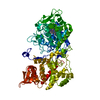
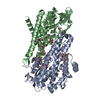
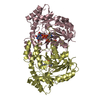
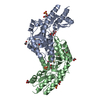
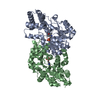
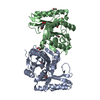
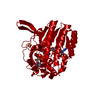
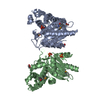
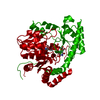
 PDBj
PDBj





